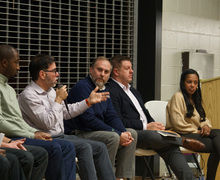How airport security has increased since 9/11
Pablo Piedra | Contributing Photographer
The federal government tightens airport security after the Sept. 11 attacks.
Victor Asal has flown before and after Sept. 11, 2001 and noted significant changes in security measures at airports.
Asal, an associate professor in the department of political science at the State University of New York University at Albany, is affiliated with College of Emergency Preparedness, Homeland Security and Cybersecurity, as well as the National Consortium for the Study of Terrorism and Responses to Terrorism.
“I’m old enough to have flown before and after 9/11,” Asal said. “Basically, what happened was that overnight the flying experience was dramatically altered. It’s not like you didn’t have lines before, but they dramatically slowed down the process. In the first few months after 9/11 it was just crazy, but the TSA has gotten much better and found ways to be more efficient.”
Whether or not these tactics are effective, Asal said, is still an open question until they actually need to be tested in a real life situation, but he still appreciates that the government has maintained efforts to make airports a safer place.
In wake of 9/11, the federal government has taken a series of measures to forestall future attacks. The federal government created the Transportation Security Administration. Congress also passed the Aviation and Transportation Security Act in November 2001, introducing more extensive security screenings and stricter limitations as to what passengers can travel with, according to the International Business Times.
The Federal Aviation Administration also established policies after 9/11 to prevent the takeover of planes that occurred. Specifically, cockpits are locked and can only be opened by the pilot from the inside, according to the article.
William Banks, the founding director of the Institute of National Security and Counterterrorism at Syracuse University, also spoke of his experience with airport security after 9/11.
Banks said even though the institute hasn’t worked directly with local airports, we’ve all seen increased security elsewhere.
“Go to an event at the Dome, security. Rock concert, security. Enter a public place downtown, in many cases you’ll see security. You grew up with this through your childhood. If your parents took you traveling, you went through that,” Banks said.
Banks also said it’s important to think about the global context surrounding airport security.
“My European friend said to me, not long after 9/11, ‘Get used to it. It’s what we’ve been living with for a long time: cameras, surveillance, presence of security, armed security in public places and public buildings — airports, train stations,’” Banks said. “I think in many ways he was correct. We are now a part of that real-world environment that has to pay close attention to security. While, again, paying careful attention not to sacrifice our liberties and freedoms while we are protecting our citizens.”
The Daily Orange reached out to Syracuse Hancock International Airport and the office of former Syracuse mayor, Matt Driscoll, regarding changes to the airport after 9/11. Neither responded to requests for comment.
Published on September 14, 2016 at 8:16 pm
Contact BreeAnna: blposhek@syr.edu





